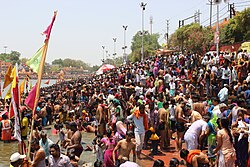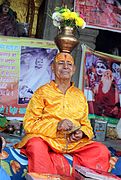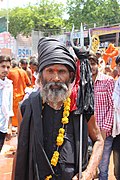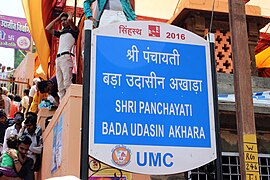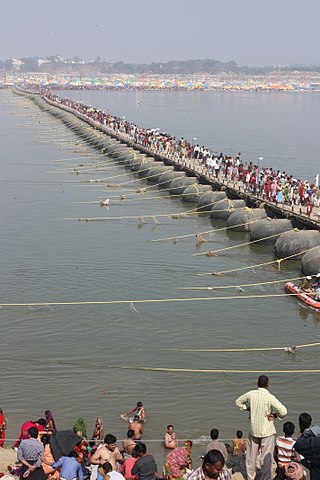
Kumbh Mela or Kumbha Mela is a major pilgrimage and festival in Hinduism. It is celebrated in a cycle of approximately 12 years, to celebrate every revolution Brihaspati (Jupiter) completes, at four river-bank pilgrimage sites: Prayagraj, Haridwar (Ganges), Nashik (Godavari), and Ujjain (Shipra). The festival is marked by a ritual dip in the waters, but it is also a celebration of community commerce with numerous fairs, education, religious discourses by saints, mass gatherings of monks, and entertainment. The seekers believe that bathing in these rivers is a means to prāyaścitta for past mistakes, and that it cleanses them of their sins.

The Shri Trimbakeshwar Shiva Temple is an ancient Hindu temple in the town of Trimbak, in the Trimbakeshwar tehsil in the Nashik District of Maharashtra, India, 28 km from the city of Nashik and 40 km from Nashik road. It is dedicated to the Hindu god Shiva and is one of the twelve jyotirlingas where the Hindu genealogy registers at Trimbakeshwar, Maharashtra are kept. The origin of the sacred Godavari river is near Trimbak.

Mela is a Sanskrit word meaning "gathering" or "to meet" or a "fair". It is used in the Indian subcontinent for all sizes of gatherings and can be religious, commercial, cultural or sport-related. In rural traditions melas or village fairs were of great importance. This led to their export around the world by South Asian diaspora communities wishing to bring something of that tradition to their new countries.

The Ramanandi, also known as Ramavats, Ramananda sect is the largest sect of Vaishnavas, out of 52 gates of Vaishnavism divided into 4 Vaishnava Sampradaya, 36 are held by Ramanandi's. They mainly emphasise the worship of Rāma, Sita, and Hanuman and also on other incarnations. They considers Ram and Sita as Supreme Absolute who are non different from eachother.
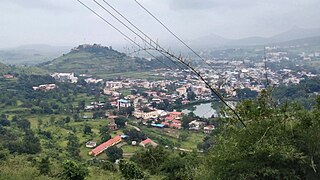
Trimbak is a city and a municipal council in Nashik District in the Indian state of Maharashtra. The Trimbakeshwar Shiva Temple is located here, one of the twelve Jyotirlingas, where the Hindu genealogy registers at Trimbakeshwar, Maharashtra are kept. The origin of the sacred Godavari river is near Trimbak.

Akhara or Akhada is an Indian word for a place of practice with facilities for boarding, lodging and training, both in the context of Indian martial artists or a sampradaya monastery for religious renunciates in Guru–shishya tradition. For example, in the context of the Dashanami Sampradaya sect, the word denotes both martial arts and religious monastic aspects of the trident wielding martial regiment of the renunciating sadhus.

Ranoji Shinde was the founder of the Scindia dynasty, a Maratha clan that produced outstanding Maratha military commanders during the 18th century. Later the Scindia served as vassals of the British from the northern Princely state of Gwalior.

Yātrā, in Indian-origin religions, Hinduism, Buddhism, Jainism and Sikhism, generally means a pilgrimage to holy places such as confluences of sacred rivers, sacred mountains, places associated with Hindu epics such as the Mahabharata and Ramayana, and other sacred pilgrimage sites. Visiting a sacred place is believed by the pilgrim to purify the self and bring one closer to the divine. The journey itself is as important as the destination, and the hardships of travel serve as an act of devotion in themselves.
Ram Kishor was the 13th head of the Ramsnehi Sampradaya.
The Akhil Bharatiya Akhara ParishadABAP, one of the organizations of Hindu sants (saints) and sadhus (ascetics) in India. The ABAP is composed of 14 akharas, or organisations of Hindu sants and sadhus. Nirmohi Akhara and Shri Dattatreya Akhara are two of the prominent akharas which are part of it.
Baba Rampuri, born William A. Gans, also known as Baba Ram Puri -ji is an American born Sadhu. He claims to be the first westerner to become a Naga Sadhu, having been initiated in 1970. He is the author of the 2010 Destiny Books published book Autobiography of a Sadhu: A Journey into Mystic India, originally published in 2005 by Harmony/Bell Tower as Baba: Autobiography of a Blue-Eyed Yogi, and now released by Amarpuri Wellness in 2016 as Autobiography of a Sadhu: An Angrez among Naga Babas which has also been translated into German, Russian, Czech, Croatian, and Serbian. He was initiated into the religious order the Naga Sannyasis after traveling to India on a spiritual quest from his native California in 1969, at the age of 18. Like many Sadhus, he has stopped using his birth name since his initiation, refuses to give it, and is unwilling to talk about his past. He is Shri Mahant at Shri Panch Dashnam Juna Akhara.

Swami Vishwadevanand Puri was a Hindu monk and a traditional teacher of Advaita Vedanta. He founded the Vishwakalyan Foundation Trust in Haridwar.
Shri Adinath Akhara, is an ashram dedicated to Shiva. It is situated 1.5 km from the Buxar railway station at the confluence of the Ganga and Sone canals.
Mahanirvani Akhara or Shri Panchayati Akhada Mahanirvani is a Shaivite shastradhari Akhada. It is one of the three major shastradhari akhadas in Hindu tradition.

Haridwar Kumbh Mela is a mela, associated with Hinduism and held in the city of Haridwar, India held every 12 years. The exact date is determined according to Hindu astrology: the Mela is held when Jupiter is in Aquarius and the Sun enters Aries. The event possesses deep religious significance to Hindus as well as other spiritual seekers. Historically, it was an important commercial event and was attended by merchants from as far as Arabia.

Nirmala also known as Nirmala Saṁpardā or Nirmal Paṅth, is a Sikh sect of ascetics. According to the traditional beliefs, the Sanatan Nirmala Sikh tradition was founded by Guru Gobind Singh in late 17th century when he sent five Sikhs to Varanasi to learn Sanskrit and Vedanta texts.

Nashik-Trimbakeshwar Simhastha is a Hindu religious mela held every 12 years in the Nashik district of Maharashtra, India. The name of the festival is also transliterated as Sinhastha or Singhastha. It is one of the four fairs traditionally recognized as Kumbha Melas, and is also known as Nashik-Trimbak Kumbha Mela or Nashik Kumbha Mela.

The Prayag Kumbh Mela, also known as Allahabad Kumbh Mela is a mela, or religious gathering, associated with Hinduism and held in the city of Prayagraj, India, at the Triveni Sangam, the confluence of the Ganges, the Yamuna, and the mythical Sarasvati river. The festival is marked by a ritual dip in the waters, but it is also a celebration of community commerce with numerous fairs, education, religious discourses by saints, mass feedings of monks or the poor, and entertainment spectacle. Approximately 50 and 30 million people attended the Allahabad Ardh Kumbh Mela in 2019 and Maha Kumbh Mela in 2013 respectively to bathe in the holy river Ganges, making them the largest peaceful gathering events in the world.

The culture of the city of Nashik, in northwestern Maharashtra, is centred around Hindu customs and festivals.
Kinnar Akhara is an akhara established in 2018 by the hijra community. It is under the Juna Akhada. The organization showcased itself at the 2019 Kumbh Mela. The organization promotes discussion of Hinduism and LGBT topics.
